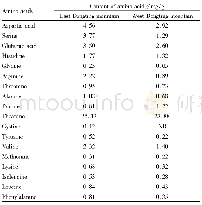《Table 3 Measurement results of dimensions of single track deposited with different magnetic field c
 提示:宽带有限、当前游客访问压缩模式
提示:宽带有限、当前游客访问压缩模式
本系列图表出处文件名:随高清版一同展现
《电磁辅助激光修复Inconel718高温合金的组织及拉伸性能(英文)》
The macro morphologies of the laser repaired blocky samples are shown in Fig.5.All the processing parameters used are the same except the magnetic field currents applied.The repaired sample without EMS is shown in Fig.5a,and Fig.5b~5d are repaired samples deposited with magnetic field currents of 20,40 and 60 A,respectively.Fig.5a shows the macro morphology of laser repaired sample without adding of magnetic field current,and it can be seen that there is a single track forming trajectory obviously.There is a shallow groove between adjacent single tracks due to the presence of a large surface tension of the molten metal which resulted in not fully expanding of the molten metal.The surface of the deposited layer is becoming smoother when the applied magnetic filed intensities increase,as shown in Fig.5b~5d.The smoothing was attributable to a case that Lorentz force was produced in liquid metal by electromagnetic stirring process and this made the liquid metal convert in molten pool sharply.The effect of convection overcomes the viscous resistance of surface tension and spreading,forming a relatively smooth surface.With the increase of magnetic field current to 20 A,the trace of single track becomes indistinct,but the last track of repaired morphology is still observed as shown in Fig.5b.It is not easy to observe the forming trajectory obviously in Fig.5c when the applied magnetic field current is 40 A,and the surface forming is uniform and smooth.The morphology of repaired sample with a magnetic field current of 60 A is irregularity surface and smooth forming relatively.It can be seen that with the increasing of the magnetic field current,the surface morphology is smoother.Electromagnetic stirring can achieve a significant improvement in the spreadability of the liquid molten metal.This agrees with the experimental results in Fig.4 and Table 3.
| 图表编号 | XD0011272200 严禁用于非法目的 |
|---|---|
| 绘制时间 | 2018.10.01 |
| 作者 | 程洪茂、刘奋成、杨光、仲超、林鑫、黄春平 |
| 绘制单位 | 南昌航空大学轻合金加工科学与技术国防重点学科实验室、南昌航空大学轻合金加工科学与技术国防重点学科实验室、沈阳航空航天大学航空制造工艺数字化国防重点学科实验室、南昌航空大学轻合金加工科学与技术国防重点学科实验室、西北工业大学凝固技术国家重点实验室、南昌航空大学轻合金加工科学与技术国防重点学科实验室、西北工业大学凝固技术国家重点实验室 |
| 更多格式 | 高清、无水印(增值服务) |





